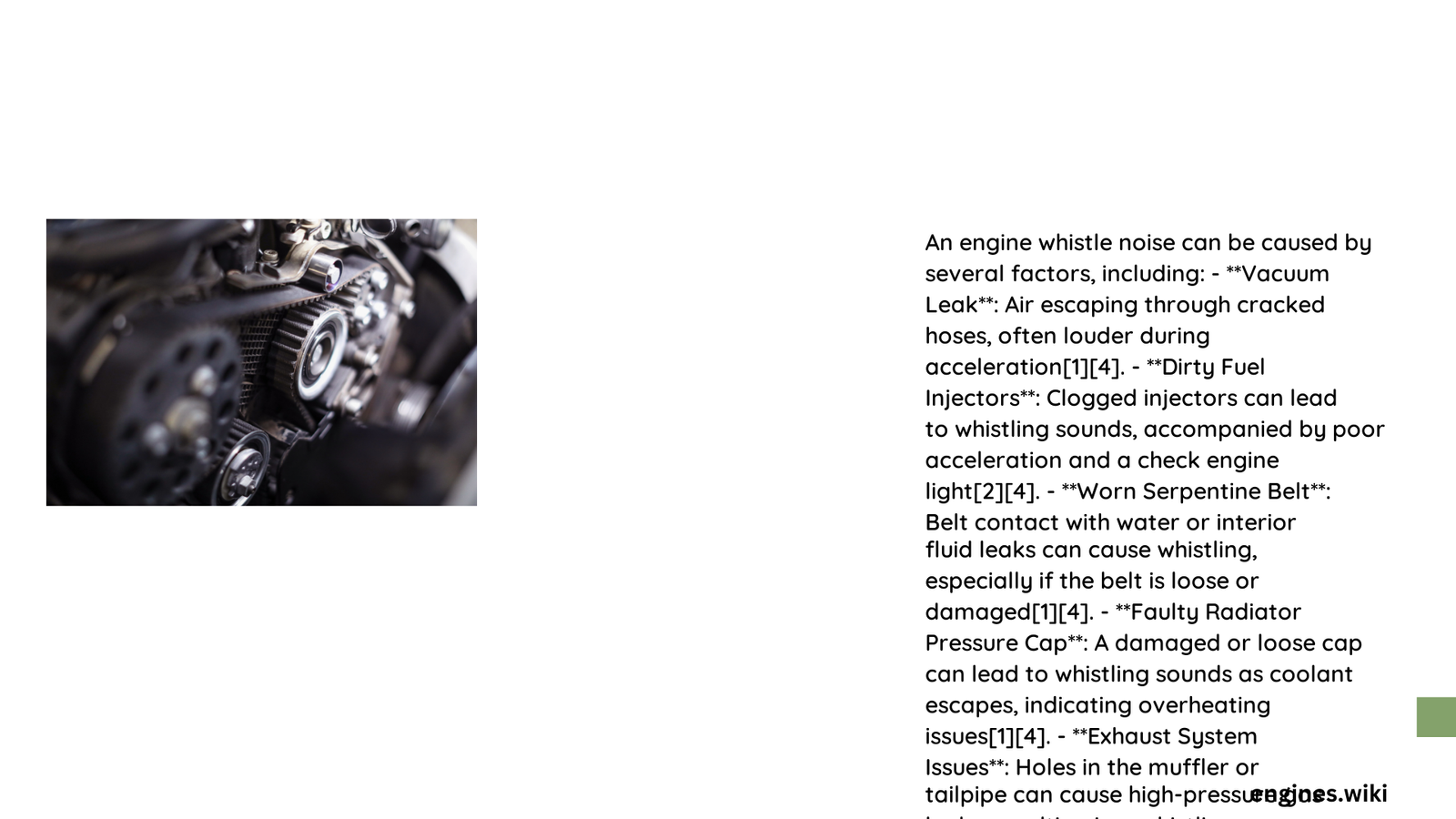Understanding Engine Whistle Noise: A Comprehensive Guide
Quick Overview of Engine Whistle Noise
Engine whistle noise can be a perplexing and concerning sound for vehicle owners, often indicating underlying mechanical issues that require immediate attention. This high-pitched sound can emerge from various components within your vehicle’s engine system, ranging from minor vacuum leaks to more complex mechanical problems that demand professional intervention.
What Causes Engine Whistle Noise?
1. Can Vacuum Leaks Create Whistling Sounds?
Vacuum leaks are a primary culprit behind engine whistle noise. These leaks occur when:
- Air escapes through damaged hoses
- Connections between engine components become compromised
- Intake manifold seals deteriorate
Diagnostic Checklist:
– Inspect vacuum hoses for visible cracks
– Check connection points for looseness
– Use electronic leak detection tools
2. How Do Dirty Fuel Injectors Contribute to Whistling?
Fuel injectors play a critical role in maintaining proper air-fuel mixture. When they become dirty or clogged, they can produce:
- Irregular fuel spray patterns
- Disrupted combustion processes
- Subtle whistling sounds
Maintenance Recommendations:
– Clean fuel injectors every 60,000 miles
– Use high-quality fuel additives
– Replace fuel filters regularly
3. What Role Does the Serpentine Belt Play in Engine Noise?
The serpentine belt is a crucial component that can generate whistling sounds when:
- Belt becomes worn or glazed
- Tension is incorrect
- Belt is exposed to moisture
| Belt Condition | Potential Noise | Recommended Action |
|---|---|---|
| Worn | High-pitched squeal | Immediate replacement |
| Loose | Intermittent whistle | Adjust tension |
| Wet | Squeaking sound | Dry and inspect |
4. Can Radiator Pressure Caps Cause Whistling?
A faulty radiator pressure cap can create unexpected whistling by:
- Failing to maintain proper cooling system pressure
- Allowing air to escape
- Compromising overall cooling efficiency
Warning Signs:
– Inconsistent engine temperature
– Steam from engine compartment
– Unusual whistling during operation
5. How Do Window Seals Impact Engine Noise?
While not directly engine-related, worn window seals can:
- Create wind-related whistling at high speeds
- Simulate engine noise
- Indicate potential weatherproofing issues
Professional Diagnostic Techniques
Essential Tools for Noise Detection
- Automotive stethoscope
- Ultrasonic leak detector
- Pressure testing equipment
- Starting fluid (for leak identification)
Repair and Maintenance Strategies
Cost-Effective Solutions
- Regular maintenance prevents costly repairs
- Early detection reduces potential damage
- Professional inspection recommended for complex issues
Prevention and Long-Term Care
Key Maintenance Tips:
– Perform regular vehicle inspections
– Use high-quality automotive components
– Address unusual sounds immediately
– Follow manufacturer’s recommended service intervals
Expert Recommendations
Vehicle experts suggest:
– Never ignore persistent engine noises
– Consult professional mechanics for complex diagnostics
– Maintain comprehensive service records
– Invest in preventative maintenance
Technical Insights
The complexity of engine whistle noise requires a systematic approach:
1. Identify the specific noise characteristics
2. Isolate potential sources
3. Conduct targeted diagnostic tests
4. Implement precise repair strategies
Conclusion
Understanding engine whistle noise involves recognizing subtle mechanical signals and responding proactively. While some causes are minor, others can indicate significant mechanical challenges requiring immediate attention.

